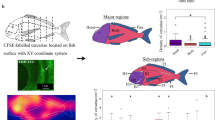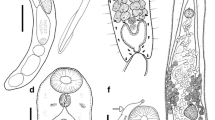Abstract
The entrance into host tissues by the cercaria of the digeneanDiplostomum spathaceum and the parasite's migration to the eyes of the fish host (post-penetration larvae) were studied by scanning and transmission electron microscopy at the ultrastructural level and by a radiometric assay in experimentally infected rainbow trout (Oncorhynchus mykiss). It was demonstrated that cercariae penetrated the host surface at several sites, although the major site involved the gill region. This observation was verified by the measurement of radioactivity in different regions of fish at intervals following their exposure to cercariae that had been radiolabeled with selenium in vivo. The migratory routes of the post-penetration-labeled cercariae (diplostomulum) were followed along with the distribution of radiactivity, which was altered with increasing time after exposure in the different regions of the host. A marked increase in radioactivity was noted, particularly in the eyes of the host, whereas the radiolabel decreased elsewhere. The results support the view that the cercariae ofD. spathaceum contact the host by chance. The finding that the parasite mainly penetrates the host through the gills may be connected with fish ventilation hydrodynamics. The total amount of radioactivity retained in the fish gradually decreased with time, which may suggest that only a portion of the primarily attached cercariae actually pentrated the fish. The majority of the penetrating parasites reached the eyes of the host, where they became established as metacercariae within 24 h, thus indicating migration directed to the eye region. This is facilitated by the functional morphology of the migrating stage ofD. spathaceum.
Similar content being viewed by others
References
Becker CD, Brunson WD (1966) Transmission ofDiplostomum flexicaudum to trout by ingestion of precocious metacercariae in molluscs. J Parasitol 52:829–830
Betterton C (1974) Studies on the host specificity of the eyefluke,Diplostomum spathaceum, in brown and rainbow trout. Parasitology 69:11–29
Bortz BM, Kenny GE, Pauley GB, Bunt-Milam AH (1988) Prevalence of two site-specific populations ofDiplostomum spp. in eye infections of rainbow trout,Salmo gairdneri Richardson, from lakes in Washington State, USA. J Fish Biol 33:31–43
Bruce JI, Pezzlo F, McCarthy JE, Yajima Y (1970) Migration ofSchistosoma mansoni through mouse tissue. Ultrastructure of host tissue and integument of migrating larva following cercarial penetration. Am J Trop Med Hyg 19:959–981
Chandiwana SK (1988) Use of75Se tracer and autoradiographic techniques in the study of schistosomiasis. Parasitology 97:489–503
Christensen NØ (1978) A method for the in vivo radiolabeling ofDiplostomum spathaceum, Hypoderaeum conoideum, Plagiorchiidae sp. andNotocotylus attenautus cercariae with radioselenium. Z Parasitenkd 63:47–63
Christensen NØ, Nansen P (1981) The application of radioisotope techniques in studies on host-parasite relationships — with special reference to larval trematodes. A review. In: Isotopes and radiation in Parasitology IV, Proceedings of the research meeting, Cambridge, 1979. International Atomic Energy Agency, Vienna, pp 207–216
Christensen NØ, Frandsen F, Nansen P (1979) The effect of some environmental conditions and final-host and parasite-related factors on the penetration ofSchistosoma mansoni cercariae into mice. Z Parasitenkd 63:47–63
Davis DJ (1936) Pathological studies on the penetration of the cercariae of the strigeoid trematodeDiplostomum flexicaudum. J Parasitol 22:324–337
Erasmus DA (1959) The migration of cercariae X Baylis (Strigeida) within the fish intermediate host. Parasitology 49:173–190
Ferguson MS (1943) Migration and localization of an animal parasite within the host. J Exp Zool 93:375–401
Haas W (1974a) Analyse der Invasionmechanismen der Cercariae vonDiplostomum spathaceum: 1. Fixation und penetration. Int J Parasitol 4:311–319
Haas W (1974b) Analyse der Invasionmechanismen der Cercariae vonDiplostomum spathaceum: II. Chemische Invasionsstimuli. Int J Parasitol 4:321–330
Haas W (1975) Einfluß von CO2 und pH auf das Fixationsverhalten der Cercariae vonDiplostomum spathaceum (Trematoda). Z Parasitenkd 46:53–60
Hoffman GL, Hoyme JB (1958) The experimental histopathology of the tumour on the brain of the stickleback caused byDiplostomum baeri eucaliae Hoffman and Hundley, 1957 (Trematoda: Strigeoidae). J Parasitol 44:374–378
Höglund J, Thuvander A (1990) Indications of non-specific protective mechanisms in rainbow trout (Oncorhynclus mykiss) with diplostomosis. Dis Aquat Org 8:91–97
Kleinow KM, Brocks AS (1986) Selenium compounds in the fathead minnow (Pimephales promelas: I. Uptake, distribution, and elimination of orally administered selenate, selenite and selenmethionine. Comp Biochem Physiol 83:61–69
Larson OR (1965) Cercarial penetration, localization and lenticular hernia in the black bulhead,Ictaluris melas. J Parasitol 15 [Suppl]:23–24
Laurent P (1983) Structure of vertebrate gills. In: Rankin JC, Pitcher TC, Duggan R (eds) Control processes in fish physiology. Croom Helm, London Canberra, pp 25–43
Margolis L, Esch GW, Holmes JC, Kurtis AM, Schad GA (1982) The use of ecological terms in parasitology (report of anad hoc Committee of the American Society of Parastiologists). J Parasitol 68:131–133
Palmieri JR, Heckmann RA, Evans RS (1976) Life cycle and incidenceDiplostomum spathaceum Rudolphi (1819) (Trematodas Diplostomatidae) in Utah. Great Basin Naturalist 36:86–96
Ratanarat-Brockelman C (1974) Migration ofDiplostomum spathaceum (Trematoda) in the fish intermediate host. Z Parasitenkd 43:123–134
Shigin AA (1986) The trematode fauna of the USSR. The diplostomatoid metacercariae. Nauka, Moscow (in russian)
Stirwalt MA, Dorsey CH (1974)Schistosoma mansoni: cercarial penetration of the host epidermis at the ultrastructural level. Exp Parasitol 35:1–15
Whyte SK, Secombes CJ, Chappell LH (1987) Cercariae and diplostomules ofDiplostomum spathaceum (Digenea) elicit an immune response in rainbow trout,Salmo gairdneri, Richardson. J Fish Biol 31 [Suppl A]:185–190
Whyte SK, Chappell LH, Secombes CJ (1988) In vitro transformation ofDiplostomum spathaceum (Digenea) cercariae and shortterm maintainance of post-penetration larvae in vitro. J Helminthol 62:293–302
Whyte SK, Secombes CJ, Chappell LH (1989) Cytotoxic reactions of rainbow trout,Salmo gairdneri, Richardson, macrophages for larvae of the eye flukeDiplostomum spathaceum (Digenea). J Fish Biol 35:333–345
Author information
Authors and Affiliations
Rights and permissions
About this article
Cite this article
Höglund, J. Ultrastructural observations and radiometric assay on cercarial penetration and migration of the digeneanDiplostomum spathaceum in the rainbow troutOncorhynchus mykiss . Parasitol Res 77, 283–289 (1991). https://doi.org/10.1007/BF00930902
Accepted:
Issue Date:
DOI: https://doi.org/10.1007/BF00930902




